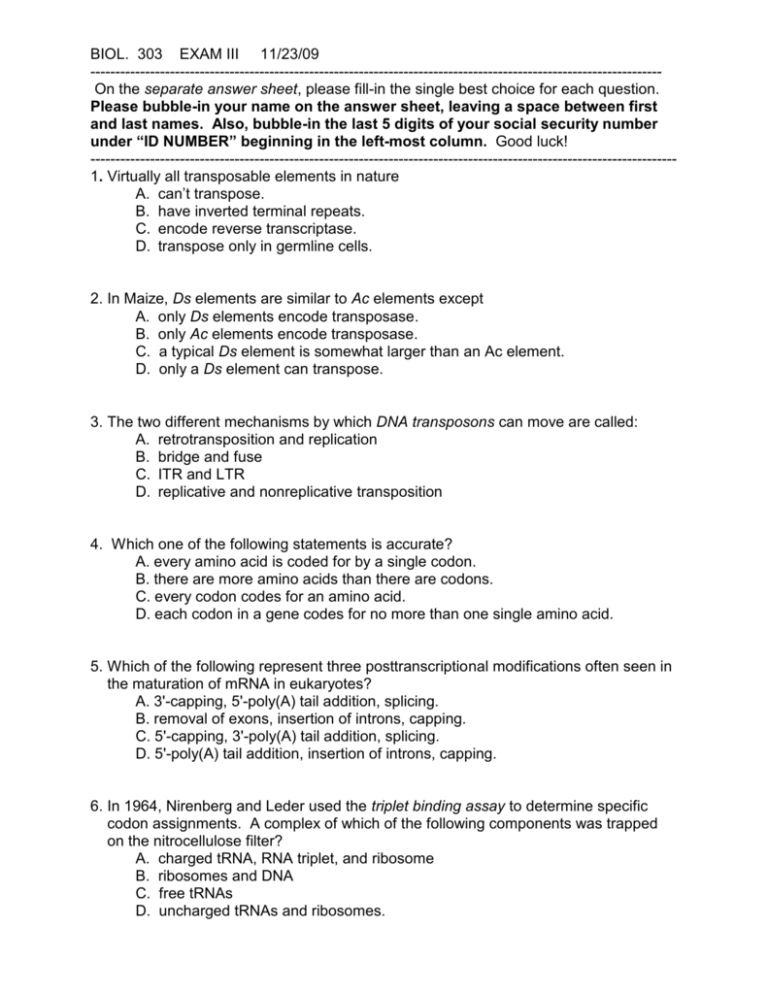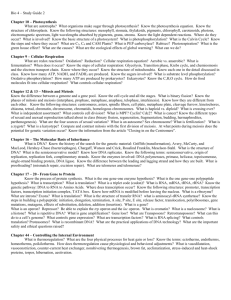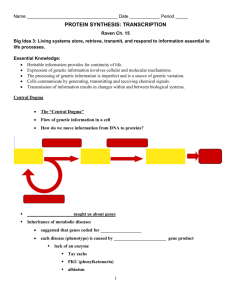EXAM3-09ANS
advertisement

BIOL. 303 EXAM III 11/23/09 ------------------------------------------------------------------------------------------------------------------On the separate answer sheet, please fill-in the single best choice for each question. Please bubble-in your name on the answer sheet, leaving a space between first and last names. Also, bubble-in the last 5 digits of your social security number under “ID NUMBER” beginning in the left-most column. Good luck! ---------------------------------------------------------------------------------------------------------------------1. Virtually all transposable elements in nature A. can’t transpose. B. have inverted terminal repeats. C. encode reverse transcriptase. D. transpose only in germline cells. 2. In Maize, Ds elements are similar to Ac elements except A. only Ds elements encode transposase. B. only Ac elements encode transposase. C. a typical Ds element is somewhat larger than an Ac element. D. only a Ds element can transpose. 3. The two different mechanisms by which DNA transposons can move are called: A. retrotransposition and replication B. bridge and fuse C. ITR and LTR D. replicative and nonreplicative transposition 4. Which one of the following statements is accurate? A. every amino acid is coded for by a single codon. B. there are more amino acids than there are codons. C. every codon codes for an amino acid. D. each codon in a gene codes for no more than one single amino acid. 5. Which of the following represent three posttranscriptional modifications often seen in the maturation of mRNA in eukaryotes? A. 3'-capping, 5'-poly(A) tail addition, splicing. B. removal of exons, insertion of introns, capping. C. 5'-capping, 3'-poly(A) tail addition, splicing. D. 5'-poly(A) tail addition, insertion of introns, capping. 6. In 1964, Nirenberg and Leder used the triplet binding assay to determine specific codon assignments. A complex of which of the following components was trapped on the nitrocellulose filter? A. charged tRNA, RNA triplet, and ribosome B. ribosomes and DNA C. free tRNAs D. uncharged tRNAs and ribosomes. 7. The process known as RNA editing A. occurs in prokaryotes only B. sometimes involves the use of “guide RNA” C. is the process of splicing out introns D. is also know as “RNA interference” 8. What term is often used to describe a set of genes expressed on a polycistronic messenger RNA? A. lysogen. B. cis control elements C. operon. D. allosteric. 9. In the lac operon, under which of the following conditions will the lac genes be transcribed at high levels? A. low glucose, low lactose B. high glucose, low lactose C. low glucose, high lactose D. high glucose, high lactose 10. The lac operon A. is regulated in eukaryotes by negative and positive control B. is under positive control only. C. is normally expressed constitutively. D. uses catabolyte repression as one means of gene regulation. 11. RNA polymerase binds to the: A. operator B. repressor C. inducer D. promoter 12. A mutant E. coli strain, grown under conditions that normally induce the lac operon, produces high amount of ß-galactosidase. What is a possible genotype of the cells? A. lacI+ lacO+ lacZ– lacY+ lacA+ B. lacIS lacO+ lacZ+ lacY+ lacA+ C. lacI– lacO+ lacZ– lacY+ lacA+ D. lacI+ lacOc lacZ+ lacY+ lacA+ 13. With regards to the trp operon, A. tryptophan is an inducer. B. tryptophan is a co-repressor. C. attenuation can halt replication. D. none of the above. 14. Under the system of genetic control of the trp operon in E. coli, A. when there are high levels of tryptophan in the medium, transcription of the trp operon occurs at high levels. B. when there are high levels of tryptophan in the medium, transcription of CAP occurs at high levels. C. when there are high levels of tryptophan in the medium, ribosomes “stall” and reduce the levels of tryptophan synthesized. D. when there is no tryptophan in the medium, transcription of the trp operon occurs at high levels. 15. Regarding the trp operon in B. subtilis, TRAP influences gene expression A. at the posttranslational level B. at the transcriptional level C. both 1 and 2 D. none of the above 16. When studying the initiation of transcription, one often finds consensus sequences located in the region of the DNA where RNA polymerase(s) bind. Which are common consensus sequences? A. CAAT, TATA B. GGTTC, TTAT C. TTTTAAAA, GGGGCCCC D. any trinucleotide repeat 17. Protein-encoding genes in eukaryotes are transcribed by A. RNA polymerase I B. RNA polymerase II C. RNA polymerase III D. RNA polymerase IV 18. Transcription factors act as. A. cis-acting regulatory elements B. trans-acting regulatory elements C. promoters D. enhancers 19. SWI-SNF proteins are involved in: A. basal transcription B. RNA interference C. repression D. chromatin remodeling 20. The “histone code” refers to A. an honor code that all histones agree to abide by. B. the genetic code used to translate a codon into an amino acid C. a set of epigenetic modifications that influences gene expression D. the fact that the core histone particle contains an octomer of histone proteins 21. Eukaryotic cells are able to carefully regulate precise levels of transcription in specific genes encoding proteins through: A. complex enhancer elements that can associate with multiple activator and repressor proteins B. production of different types of sigma factors C. attenuation D. all of the above 22. Which of the following can account for multiple proteins from a primary transcript? A. alternative splicing B. reverse transcription C. 5' methylation D. polyribosomes 23. In general, methylation of DNA in eukaryotes A. induces genetic rearrangements B. activates gene expression C. promotes cell growth D. reduces levels of gene expression 24. The term "chromatin remodeling" refers to A. a process that only bacteria perform since they contain no nucleus. B. a process that is exclusively associated with transcription by RNA polymerase III in eukaryotes. C. alteration of chromatin structure in association with transcription. D. alteration in chromatin structure to facilitate loading and translation by ribosomes and, thus, enhance gene expression. 25. The phenomenon known as “RNAi” (RNA interference) can be used experimentally to A. reduce expression of a specific target gene. B. reduce translation rate from a specific gene promoter. C. interfere with replication. D. enhance gene expression. 26. Controls that tie the integrity of the genome with progression through the cell cycle are known as: A. growth factors B. receptors C. cyclins D. checkpoints 27. The spread of cancer cells to sites away from the initial tumor is known as: A. angiogenesis B. clonal replication C. apoptosis D. metastasis 28. Genes that contribute to cancer through mutations that permanently activate the protein encoded by the gene are: A. tumor suppressor genes B. CDK inhibitors C. oncogenes D. imprinted 29. According to current thinking in cancer research, the most effective type of cancer therapy would destroy a certain type of cell. This type of cell is known as a(n) A. macrophage B. cancer stem cell C. lymphocyte D. oncofibroblast 30. Which statement is most accurate? A. cancer development involves a multi-step accumulation of mutations that always leads to a progressively worse prognosis B. typically a single mutation is involved in carcinogenesis. C. most cancers are inherited. D. sometimes cancers seem to reverse course and “vanish” although nobody is currently sure about how this occurs. 31. The tumor suppressor protein pRB blocks progression through the cell cycle A. by binding transcription factor E2F. B. upon inactivation by phosphorylation C. when it is mutated in retinoblastoma D, all of the above. 32. A restriction enzyme A. cuts DNA at random B. degrades RNA C. normally cleaves DNA within a specific sequence D. none of the above 33. What is the function of an antibiotic-resistance gene in a vector? A. To allow resistant transformants to grow in selective medium B. To distinguish introns from exons C. To screen for vectors with inserts D. To allow plasmid replication 34. What information is absent from a cDNA library? A. intron sequences B. transcription regulatory sequences C. sequences of inactive genes D. all of the above 35. Which of the following is needed in order to amplify a DNA fragment by PCR? A. a set of primers. B. knowledge of the complete nucleotide sequence of the fragment to be amplified. C. RNA polymerase. D. dideoxynucleotide triphosphates. 36. Nucleic acid blotting is widely used in recombinant DNA technology. In a Northern blot one generally A. hybridizes filter-bound DNA with a DNA probe. B. hybridizes filter-bound RNA with a labeled probe. C. examines amino acid substitutions with radioactive probes. D. cleaves RNA with restriction endonucleases. 37. Regarding the sequencing of genomes, which statement is true? A. every nucleotide of the human genome has been sequenced. B. no eukaryotic genome has yet been sequenced. C. DNA sequencing has revealed a complete lack of polycistronic transcription units in eukaryotic genomes. D. reportedly over 1000 genomes have been sequenced. 38. Compared to prokaryotic chromosomes, eukaryotic chromosomes in general A. are larger B. have interrupted genes C. display lower gene density D. all of the above 39. Analysis of the human genome has revealed that about half (or maybe more) of the human genome seems to be composed of A protein-coding genes. B. ribosomal RNA genes. C. transposons or transposon-like elements. D. satellite sequences. 40. Based on the sequencing of Craig Venter’s diploid genome, researchers have determined that A. genomes of different individuals are even more similar than previously thought B. genomes of different individuals display greater diversity than previously thought. C. the number of different human genes is greater than 50,000 D. the human and dog genomes are virtually identical. Happy Thanksgiving! _________________________________________ The turkey genome is awesome! Answer Key Q: 1, 2, 3, 4, 5, 6, 7, 8, 9,10,11,12,13,14,15,16,17,18,19,20, A: B, B, D, D, C A, B, C, C, D, D, D, B, D, B, A, B, B, D, C, Q:21,22,23,24,25,26,27,28,29,30,31,32,33,34,35,36,37,38,39,40 A: A, A, D, C, A, D, D, C ,B, D, A, C ,A, D, A, B, D, D, C, B









